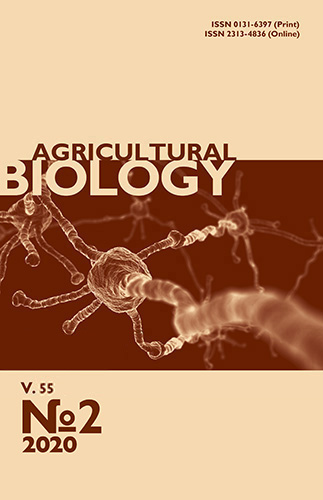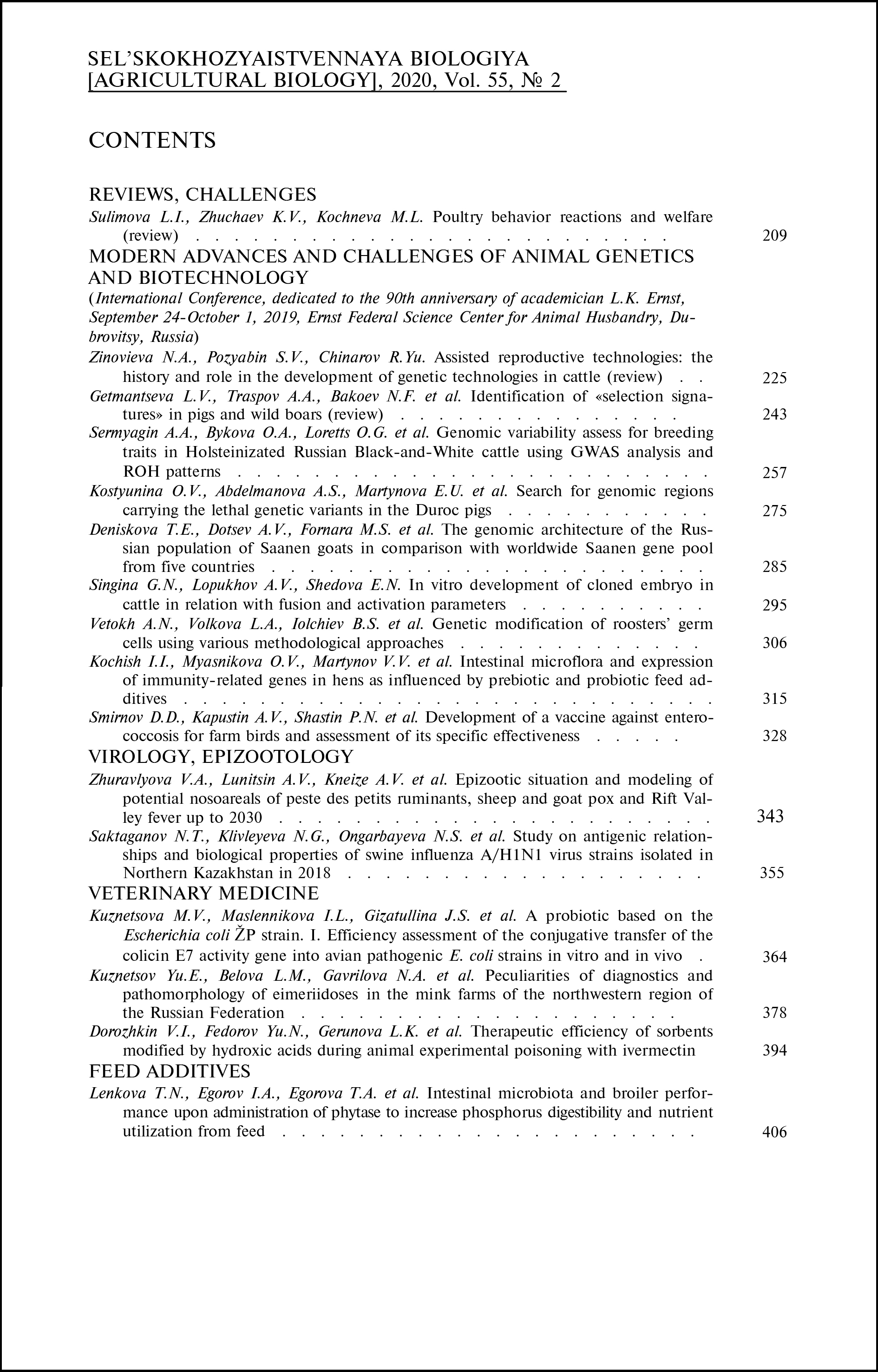doi: 10.15389/agrobiology.2020.2.406eng
UDC: 636.52/.58:636.084:579.62
Acknowledgements:
Supported financially by a grant from the Russian Science Foundation for the implementation of the scientific project 16-16-04089 “Study of the physiological and microbiological characteristics of the digestion of chicken meat in the embryonic and postembryonic periods to create new feeding technologies that ensure the fullest possible realization of the bird’s genetic potential”
INTESTINAL MICROBIOTA AND BROILER PERFORMANCE UPON ADMINISTRATION OF PHYTASE TO INCREASE PHOSPHORUS DIGESTIBILITY AND NUTRIENT UTILIZATION FROM FEED
T.N. Lenkova1, I.A. Egorov1, T.A. Egorova1, V.A. Manukyan1, V.G. Vertiprakhov1, A.A. Grozina1, I.N. Nikonov1, V.A. Philippova2, E.A. Yildirim2, L.A. Ilina2, A.V. Dubrovin2, G.Yu. Laptev2
1Federal Scientific Center All-Russian Research and Technological Poultry Institute RAS, 10, ul. Ptitsegradskaya, Sergiev Posad, Moscow Province, 141311 Russia, e-mail olga@vnitip.ru, dissovet@vnitip.ru (✉ corresponding author) , manukyan@vnitip.ru, eta164@mail.ru, ilnikonov@yandex.ru, vertiprakhov63@mail.ru, alena_fisinina@mail.ru;
2JSC «Biotrof+», 19 korp. 1, Zagrebskii bulv., St. Petersburg, 192284 Russia, e-mail ilina@biotrof.ru, deniz@biotrof.ru, laptev@biotrof.ru
ORCID:
Lenkova T.N. orcid.org/0000-0001-8026-3983
Nikonov I.N. orcid.org/0000-0001-9495-0178
Egorov I.A. orcid.org/0000-0001-9122-9553
Philippova V.A. orcid.org/0000-0001-8789-9837
Egorova T.A. orcid.org/0000-0002-5102-2248
Yildirim E.A. orcid.org/0000-0002-5846-5105
Manukyan V.A. orcid.org/0000-0003-4564-4427
Ilina L.A. orcid.org/0000-0003-2490-6942
Vertiprakhov V.G. orcid.org/0000-0002-3240-7636
Dubrovin A.V. orcid.org/0000-0001-8424-4114
Grozina A.A. orcid.org/0000-0002-3088-0454
Laptev G.Yu. orcid.org/0000-0002-8795-6659
Received December 10, 2018
Phosphorus is an essential element in the nutrition of humans, animals, and plants. Due to the short growth period (34-42 days of age), fast growth of live bodyweight and skeleton the problem of mineral nutrition and balance (including calcium and phosphorus) is especially urgent for broiler chicks (Gallus gallus L.). The predominant form of phosphorus in vegetable feed ingredients is phytate which is an antinutritive factor for poultry and cannot be digested. As a result the supplementation of diets for poultry with phytases, enzymes degrading the indigestible phytate complexes, has gradually become a common practice worldwide. The recent data of Russian (O.V. Trufanov, 2011; E.V. Anchikov, 2012) and foreign authors (S.W. Kim et al., 2018; C.L. Walk et al., 2019; O.O. Babatunde et al., 2019) evidenced that the supplementation of diets with reduced phosphorus content with different doses of phytase improves daily weight gains, phosphorus content in blood serum, tibial strength, and tibial contents of minerals. The efficiency of supplementation of diets for broilers (cross Cobb 500) with reduced by 0.1 % phosphorus content with two innovative new-generation phytase preparations (Feedbest-P and Berzyme-P, produced by Sibbiopharm Co., Russia) was studied; the data of pioneer research of the effects of different phytase preparations on the cecal microbial community are also presented. The trials were performed in the Center for Genetics & Selection Zagorskoye EPH (Moscow Province) in 2018. In the first trial the diets for experimental treatments were supplemented with phytase preparation 1 with activity 10,000 FTU/g (20, 40, and 60 ppm); in the second trial phytase preparation 2 was used with activity 50,000 FTU/g (6, 12, and 30 ppm). The supplementation of diets with preparation 1 increased live bodyweight in broilers at 37 days of age by 2.7; 3.0 and 3.7 % (respective to aforementioned doses) in compare to non-supplemented control treatment; feed conversion ratio (FCR) in these treatments was better by 2.9; 4.0 and 4.6 %, respectively. The respective improvements with different doses of preparation 2 were 1.3; 3.1 and 2.0 % and 1.9; 5.6 and 3.7 %. Positive effects on the digestibility of dietary nutrients, deposition of calcium and phosphorus, mineral contents in the skeleton were found with both phytase preparations. The investigation of cecal microbiota using T-RFLP (terminal restriction fragment length polymorphism) method revealed the significant increase in the pool of cellulolytic bacterial species in the phytase-fed broilers; the increases in the species of Eubacteriaceae, Clostridiaceae, Lachnospiraceae, Ruminococcaceae, and Bacteroidetes were also found. The most of the identified bacterial species in cecal population were ascribed to the phylums Firmicutes, Bacteroidetes, Actinobacteria, Proteobacteria andFusobacteria.
Keywords: Gallus gallus, phytase, compound feeds, broiler chicks, productive performance, cecal microbiota.
REFERENCES
- Trufanov O.V. Fitaza v kormlenii sel'skokhozyaistvennykh zhivotnykh [Phytase in feeding farm animals]. Kiev, 2011 (in Russ.).
- Ravindran V. Phytases in poultry nutrition. An overview. Proceedings of Australian Poultry Science Symposium, 1995, 7: 135-139.
- Singh P.K. Significance of phytic acid and supplemental phytase in chicken nutrition: a review. World's Poultry Science Journal, 2008, 64(4): 553-580 CrossRef
- Anchikov E.V. Fitaza v kombikormakh dlya broilerov. Avtoreferat kandidatskoi dissertatsii [Phytase in feed for broilers. PhD Thesis]. Sergiev Posad, 2012 (in Russ.).
- Selle P., Anchikov E. Kombikorma, 2010, 3: 81-85 (in Russ.).
- Uord N., Glitso V. Kombikorma, 2014, 1: 78 (in Russ.).
- Shirley R.B., Edwards H.M. Jr. Graded levels of phytase past industry standards improves broiler performance. Poultry Science, 2003, 82(4): 671-680 CrossRef
- Walk C.L., Rama Rao S.V. Increasing dietary phytate has a significant anti-nutrient effect on apparent ileal amino acid digestibility and digestible amino acid intake requiring increasing doses of phytase as evidenced by prediction equations in broilers. Poultry Science, 2020, 99(1): 290-300 CrossRef
- Babatunde O.O., Cowieson A.J., Wilson J.W., Adeola O. The impact of age and feeding length on phytase efficacy during the starter phase of broiler chickens. Poultry Science, 2019, 98(12): 6742-6750 CrossRef
- Kim S.W., Li W., Angel R., Proszkowiec-Weglarz M. Effects of limestone particle size and dietary Ca concentration on apparent P and Ca digestibility in the presence or absence of phytase. Poultry Science, 2018, 97(12): 4306-4314 CrossRef
- Roofchaei A., Rezaeipour V., Vatandour S., Zaefarian F. Influence of dietary carbohydrases, individually or in combination with phytase or an acidifier, on performance, gut morphology and microbial population in broiler chickens fed a wheat-based diet. Animal Nutrition, 2019, 5(1): 63-67. CrossRef
- Apajalahti J., Kettunen A., Graham H. Characteristics of the gastrointestinal microbial communities, with special reference to the chicken. World's Poultry Science Journal, 2004, 60(2): 223-232 CrossRef
- Amit-Romach E., Sklan D., Uni Z. Microflora ecology of the chicken intestine using 16S ribosomal DNA primers. Poultry Science, 2004, 83(7): 1093-1098 CrossRef
- Lan Y., Verstegen M.W.A., Tamminga S., Williams B.A. The role of the commensal gut microbial community in broiler chickens. World's Poultry Science Journal, 2005, 61(1): 95-104 CrossRef
- Adegunloye D.V. Microorganism associated with poultry faeces. Journal of Food, Agriculture and Environment,2006, 4: 41-42.
- Wei S., Morrison M., Yu Z. Bacterial census of poultry intestinal microbiome. Poultry Science, 2013, 92(3): 671-683 CrossRef
- Lukashenko V.S., Kavtarashvili A.Sh., Saleeva I.P. et al. Metodika provedeniya issledovanii po tekhnologii proizvodstva yaits i myasa ptitsy [Egg and poultry production technology — methodology for research]. Sergiev Posad, 2008 (in Russ.).
- Egorov I.A., Manukyan V.A., Lenkova T.N., Okolelova T.M., Lukashenko V.S., Shevyakov A.N., Ignatova G.V., Egorova T.V., Andrianova E.N., Rozanov B.L., Lysenko M.A., Egorova T.A., Grozina A.A., Laptev G.Yu., Nikonov I.N., Aleksandrova I.L., Il'ina L.A., Novikova N.I. Metodika provedeniya nauchnykh i proizvodstvennykh issledovanii po kormleniyu sel'skokhozyaistvennoi ptitsy. Molekulyarno-geneticheskie metody opredeleniya mikroflory kishechnika /Pod redaktsiei V.I. Fisinina, I.A. Egorova [Methods of scientific and farm tests on feeding poultry. Molecular genetic methods for the determination of intestinal microflora. V.I. Fisinin, I.A. Egorov (eds.)]. Sergiev Posad, 2013 (in Russ.).
- Uilson K., Uolker Dzh. Printsipy i metody biokhimii i molekulyarnoi biologii [Principles and methods of biochemistry and molecular biology]. Moscow, 2013 (in Russ.).
- Lakin G.F. Biometriya [Biometrics]. Moscow, 1990 (in Russ.).
- Borda-Molina D., Seifert J., Camarinha-Silva A. Current perspectives of the chicken gastrointestinal tract and its microbiome. Computational and Structural Biotechnology Journal, 2018, 16: 131-139 CrossRef
- Lu J., Idris U., Harmon B., Hofacre C., Maurer J.J., Lee M.D. Diversity and succession of the intestinal bacterial community of the maturing broiler chicken. Applied and Environmental Microbiology, 2003, 69(11): 6816-6824 CrossRef
- Józefiak D., Rutkowski A., Kaczmarek S., Jensen B.B., Engberg R.M., Hojberg O. Effect of b-glucanase and xylanase supplementation of barley- and rye-based diets on caecal microbiota of broiler chickens. British Poultry Science, 2010, 51(4): 546-557 CrossRef
- Singh K.M., Shah T., Deshpande S., Jakhesara S.J., Koringa P.G., Rank D.N., Joshi C.G. High through put 16S rRNA gene-based pyrosequencing analysis of the fecal microbiota of high FCR and low FCR broiler growers. Mol. Biol. Rep., 2012, 39: 10595-10602 CrossRef
- Ptak A., Bedford M.R., Świątkiewicz S., Żyła K., Józefiak D. Phytase modulates ileal microbiota and enhances growth performance of the broiler chickens. PLoS ONE, 2015, 10(3): e0119770 CrossRef
- Peterson E. H. Clostridium novyi isolated from chickens. Poultry Science, 1964, 43(4): 1062-1063. CrossRef
- Cooper K.K., Theoret J.R., Stewart B.A., Trinh H.T., Glock R.D., Songer J.G. Virulence for chickens of Clostridium perfringens isolated from poultry and other sources. Anaerobe, 2010, 16(3): 289-292 CrossRef
- Abd-Elsamee M.O. Effect of different levels of crude protein, sulphur amino acids, microbial phytase and their interaction on broiler chick performance. Egypt. Poult. Sci., 2002, 22: 999-1021.
- Selle P.H., Ravindran V., Partridge G.G. Beneficial effects of xylanase and/or phytase inclusions on ileal amino acid digestibility, energy utilisation, mineral retention and growth performance in wheat-based broiler diets. Animal Feed Science and Technology, 2009, 153(3-4): 303-313 CrossRef
- Deniz G., Gezen S.S., Kara C., Gencoglu H., Meral Y., Baser E. Evaluation of nutrient equivalency of microbial phytase in hens in late lay given maize-soybean or distiller’s dried grains with solubles (DDGS) diets. British Poultry Science, 2013, 54(4): 494-502 CrossRef
- Liu N., Ru Y.J. Effect of phytate and phytase on the ileal flows of endogenous minerals and amino acids for growing broiler chickens fed purified diets. Animal Feed Science and Technology, 2010, 156(3-4): 126-130 CrossRef
- Cowieson A., Ravindran V. Effect of phytic acid and microbial phytase on the flow and amino acid composition of endogenous protein at the terminal ileum of growing broiler chickens. British Journal of Nutrition, 2007, 98(4): 745-752 CrossRef
- Englmaierová M., Skřivan M., Skřivanová E., Čermák L. Limestone particle size and Aspergillus niger phytase in the diet of older hens. Italian Journal of Animal Science, 2017: 608-615 CrossRef
- de Sousa J.P.L., Albino L.F.T., Vaz R.G.M.V., Rodrigues K.F., da Silva G.F., Renno L.N., Barros V.R.S.M., Kaneko I.N. The effect of dietary phytase on broiler performance and digestive, bone, and blood biochemistry characteristics. Rev. Bras. Cienc. Avic., 2015, 17(1): 69-76 CrossRef
- Abbasi M., Zaghari M., Ganjkhanlo M., Khalaji S. Is dietary iron requirement of broiler breeder hens at the late stage of production cycle influenced by phytase supplementation? Journal of Applied Animal Research, 2015, 43(2): 166-176 CrossRef












